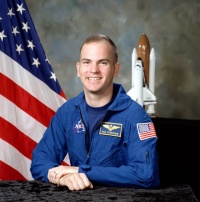Frederick W. Rick Sturckow
From The Space Library
 Frederick W. Rick Sturckow | |
| Birth Name | Frederick W. Rick Sturckow |
|---|---|
| Birth Date | Aug 11 1961 |
| Occupation | DEPUTY CHIEF, ASTRONAUT OFFICE, JOHNSON SPACE CENTER, (COLONEL, USMC, RET.) |
Contents |
[edit] Personal Data
Born August 11, 1961, and raised on a farm near Lakeside, California. Married to the former Michele A. Street of Great Mills, Maryland. He enjoys flying and physical training (PT). His father, Karl H. Sturckow, resides in Lakeside and his mother, Janette R. Sturckow, resides in La Mesa, California.
[edit] Education
Graduated from Grossmont High School, La Mesa, California, in 1978. Bachelor of Science degree in Mechanical Engineering from California Polytechnic State University, 1984.
[edit] Experience
Sturckow was commissioned in December, 1984. An Honor Graduate of The Basic School, he earned his wings in April, 1987. Following initial F/A-18 training at VFA-125, he reported to VMFA-333, MCAS Beaufort, South Carolina. While assigned to VMFA-333 he made an overseas deployment to Japan, Korea, and the Philippines and was then selected to attend the Navy Fighter Weapons School (TOPGUN) in March, 1990. In August of 1990 he deployed to Sheik Isa Air Base, Bahrain for a period of eight months. Sturckow flew a total of forty-one combat missions during Operation Desert Storm. In January, 1992 he attended the United States Air Force Test Pilot School at Edwards AFB, California. In 1993 he reported to the Naval Air Warfare Center- Aircraft Division, Patuxent River, Maryland for duty as the F/A-18 E/F Project Pilot. Sturckow also flew a wide variety of projects and classified programs as an F/A-18 test pilot. He has logged over 4,790 flight hours and has flown over 50 different aircraft.
[edit] Spaceflight Experience
NASA EXPERIENCE: Selected by NASA in December 1994, Sturckow reported to the Johnson Space Center in March 1995. He completed a year of training and evaluation and was initially assigned to work technical issues for the Vehicle Systems and Operations Branch of the Astronaut Office. Since then he has served as Deputy for the Shuttle Operations Branch of the Astronaut Office, Lead for KSC Operations Support, Chief of the Astronaut Office CAPCOM Branch, and Chief of the Astronaut Office ISS Branch. A veteran of four space flights, Sturckow has logged over 1200 hours in space. He served as pilot on STS-88 in 1998 (the first International Space Station assembly mission), and on STS-105 (2001) and was the Crew Commander on STS-117 (2007) and STS-128 (2009). Colonel Sturckow retired from the United States Marine Corps while on board the International Space Station in September, 2009, after 25 years of active duty service. Sturckow currently serves as Deputy Chief of the Astronaut Office. STS-88 Endeavour (December 4-15, 1998) was the first International Space Station assembly mission. During the 12-day mission, Unity, the U.S. built node, was mated with Zarya, the Russian built Functional Cargo Block (FGB). Two crew members performed three space walks to connect umbilicals and attach tools/hardware in the assembly and outfitting of the station. Additionally, the crew performed the initial activation and first ingress of the International Space Station preparing it for future assembly missions and full time occupation. The crew also performed IMAX Cargo Bay Camera (ICBC) operations, and deployed two satellites, Mighty Sat 1 built by the USAF Phillips Laboratory and SAC-A the first successful launch of an Argentine satellite. The mission was accomplished in 185 orbits of the Earth in 283 hours and 18 minutes. STS-105 Discovery (August 10-22, 2001) was the 11th mission to the International Space Station. While at the orbital outpost, the STS-105 crew delivered the Expedition 3 crew, attached the Leonardo Multi-Purpose Logistics Module, and transferred over 2.7 metric tons of supplies and equipment to the station. During the mission, two spacewalks were performed by two crewmembers. They also brought home the Expedition 2 crew. The STS-105 mission was accomplished in 186 orbits of the Earth, traveling over 4.9 million miles in 285 hours and 13 minutes. STS-117 Atlantis (June 8-22, 2007) was the 118th Shuttle mission and the 21st mission to visit the International Space Station. he successful construction and repair mission involved multiple EVAs by 4 astronauts to install the S3/4 Truss Segment, the heaviest element ever delivered by the Shuttle to the ISS. The mission also delivered and returned with an expedition crew member. STS-117 returned to land at Edwards Air Force Base, California, having traveled 5.8 million miles in 14 days. STS-128 Discovery (August 28-September 11, 2009) was the 128th Shuttle mission and the 30th to the International Space Station. The crew delivered 18,500 pounds of hardware and performed three spacewalks. STS-128 returned to land at Edwards Air Force Base, California, having traveled 5.7 million miles in 14 days.
[edit] Organizations
[edit] Special Honours
Defense Superior Service Medal, Legion of Merit, Distinguished Flying Cross, Defense Meritorious Service Medal, Single Mission Air Medal with Combat V, Strike/Flight Air Medals (4), Navy and Marine Corps Commendation Medal, Navy and Marine Corps Achievement Medal, NASA Space Flight Medals (4), NASA Exceptional Service Medal, NASA Outstanding Leadership Medals (2), NASA Distinguished Service Medal.
[edit] Other Information
Sep-10
